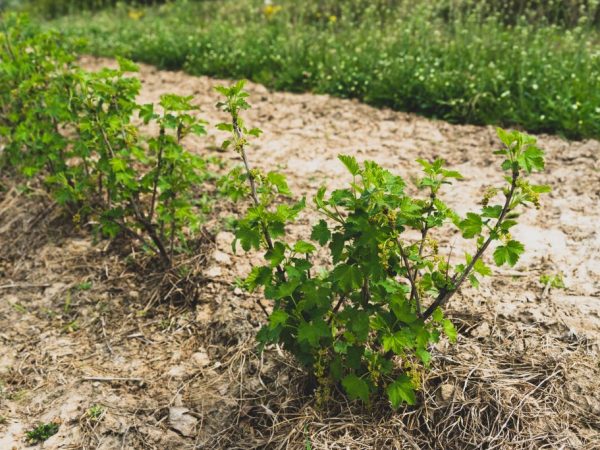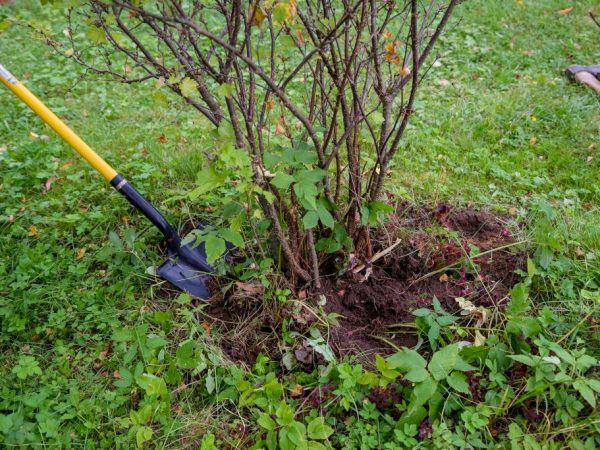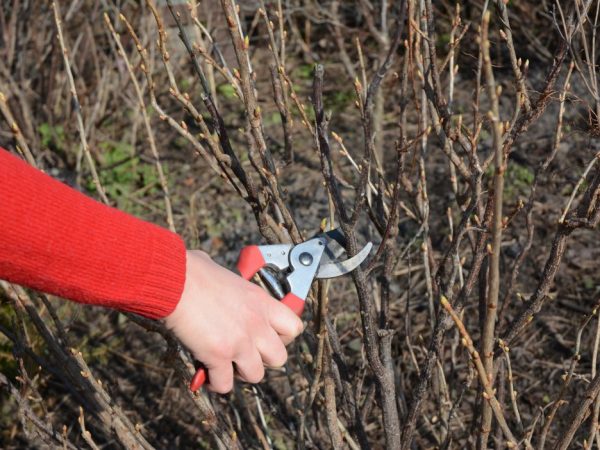How to plant currants in the fall - rules and recommendations
At the end of the season, many gardeners are planting shrubs. Currant is considered one of the most popular - it gives tasty and healthy berries every year. Consider how to plant in the fall, and what kind of care is required after that.
- Benefits of autumn planting
- Optimal timing
- Pre-planting preparation
- Selection of seedlings
- Site preparation
- The ways
- Traditional
- Fanny
- Shpalerny
- Care requirements
- Watering
- Loosening and mulching
- Top dressing
- Pruning
- Preparing for winter
- Prevention of diseases and pests
- When it begins to bear fruit
- Gardener mistakes
- Summing up

How to plant currants in the fall - rules and recommendations
Benefits of autumn planting
When planted in spring, plants have a better chance of survival, because they have enough time to take root and take root until the first stable cold weather. But at the same time, the risk of death from parasites and diseases that awaken at positive temperatures is too high.
The fall planting has several important advantages:
- friendly rooting if planted in early September;
- the likelihood of damage from diseases and pests is minimal;
- fast adaptation to new soil;
- good growth and development in spring, as well as intensive growth of green mass and root system.
This is possible only if the rules, planting dates, selection of a good place for seedlings and further care for them are observed.
Optimal timing
Depending on the growing region, the time for planting young bushes is different:
- in the North, the Urals and Siberia, early planting is recommended - at the end of summer;
- in the south, in the Rostov and Astrakhan regions, they are planted in the middle or in the last decade of September, sometimes in October, but no later than the 15th;
- in the Volga region, it is necessary to plant in the second half of October.
You also need to be guided by the weather conditions, if you hurry up and plant it in a thaw, the plant will dissolve its buds ahead of time.
From spring frosts, they can freeze, and the bush can die. This phenomenon is also possible with late planting, when the currants have not yet had time to take root, and it is cold outside.
The optimal time is about 2-3 weeks before the onset of stable autumn cold weather.
Many gardeners prefer to plant according to the lunar calendar. The most favorable days in August are 3-9, 13 and 20, in September - 2-8, 12, 17-19, 30.
Pre-planting preparation
The success of the autumn planting of berry bushes depends on the quality of the planting material, composition, soil structure, location and further care.
Selection of seedlings
For growing in the garden, you can use both purchased seedlings and grown from cuttings or an old bush divided into parts. But if you want a strong plant with all the varietal traits, go shopping at a nursery or specialty store.
Chosen according to the following criteria:
- the aerial part should also consist of two or more shoots;
- root system without injuries, lignified, covered with pile, without signs of damage from diseases and parasites;
- branches are flexible, without cracks, breaks, rot and mold.

Choose only healthy plants for planting
When choosing such a planting material, you will get a healthy plant that will quickly take root and start growing.
Site preparation
This crop prefers to grow in a sunny place where there is no strong shade, otherwise the foliage will turn pale and the berry harvest will be poor and small. You can plant red and white currants on high ground under the sun.
The black variety is best planted on a flat surface, where moisture is constantly retained. It will ensure the rapid development of the aboveground and underground parts, abundant flowering and high productivity.
Acidity is no less important - currants do not like strong acidification. The optimal level is 6 units. If the indicator is lower, the soil can be fertilized with a mineral complex designed for growing berry bushes.
With increased indicators and alkalinity, the composition of the soil must be improved:
- first remove the top layer 45-50 cm;
- then mix it with dolomite flour or slaked lime (500 g per 1 m²);
- fall asleep back on the landing site;
- add minerals - superphosphate and potassium sulfate 100 g each
The currants planted on such soil will actively grow and will give the first harvest in the second year of cultivation.
Some gardeners use compost or humus when planting this crop. For 1 m², they give a bucket of one or another component. When planting on loam, it is worth using potash mixtures, which are sold in a specialized store.
Regardless of the type of fertilizer, before lowering the roots, sprinkle the fertile composition with a thin layer of ordinary soil to eliminate the risk of burning them.
The ways
Planting pits are harvested 10 days before the planned landing. The approximate dimensions are 40x35 cm. In group cultivation, we plant seedlings at a distance of 1.5 m, and 3 m in a row.
Today, gardeners use three methods of planting this crop in the country, which are different.
Traditional
Planting instruction:
- the plant is lowered into a hole at an angle of 45 ° C;
- the root system is not fully deepened only by 10 cm (for black currants);
- the roots of red and white can be deepened by 5 cm;
- the bushes are covered with earth so that there are no voids, they are slightly trampled around the stems and watered at the rate of 3-4 liters per copy.
When planting, it is important that the soil covers the lower shoots. They will release young growth the next year in the spring.
After planting, it is necessary to trim the branches three buds from the soil surface.
Fanny
With this method of cultivation, the currants must be planted in an upright position, since the bushes will be fixed on short trellises. The planting depth of the roots is the same as in the previous case.

The landing site must be prepared in advance
After planting, it is important to thoroughly compact the soil under the bush so that the root system does not crawl out over time. You should also trim the branches to half the length.
Shpalerny
The rules for planting seedlings according to this method are different - first we cut off the branches, remove all the buds and shoots formed in the area of the root system. Then they can be seated according to the same principle of deepening as in previous cases.
After planting, the plants are no longer pruned.
Care requirements
The main care for black currants is the same as for red, white - young bushes need regular moisture, loosening, feeding and protection from diseases and pests.
Also, in order to avoid drying out, the bushes need to be shaded with burlap or agrofibre for several weeks.
Watering
In the first month, watering should be moderate, but frequent - two weeks every other day, then every five days. Water consumption for one seedling - 5 liters.
You can arrange periodic irrigation of the crown, especially in extreme heat - once every 7 days. The procedure is carried out in the evening to avoid sunburn.
Loosening and mulching
After each watering, the soil around the bushes is loosened to a depth of 4-5 cm to maintain its moisture and breathability. Then add mulch from peat or garden soil. It will protect the soil from rapid drying out and prevent the growth of unnecessary vegetation.
It is also necessary to remove weeds in time, which drown out young bushes, take away moisture, nutrients from them and are a source of reproduction of pathogenic microflora.
Top dressing
The first feeding of currants is carried out two years after planting the bushes. The best time is early spring, when the snow thaws, the soil warms up, but always before the beginning of the growing season.
Usually, mineral dressing is used several times per season:
- on the eve of flowering and budding;
- after the completion of budding, when the bushes begin to actively increase the green mass;
- at the stage of pouring berries (in early July);
- after harvesting in autumn.
To do this, take ready-made complexes, which include nitrogen, phosphorus and potassium. The scheme and dosage are indicated on the package.
You can also use wood ash - a good substitute for potassium, does not contain chlorine.
An excellent replacement option would be organic matter - compost or rotted manure. 15 kg of substance are consumed per bush, then watered abundantly.
Some gardeners alternate mineral fertilizers with organic fertilizers every year.
Additionally, foliar nutrition is carried out - sprayed with a mixture of 2 g of boric acid, 10 l of water, 2 g of zinc sulfate, 5 g of manganese and 2 g of copper sulfate. Irrigate in the evening three times per season - before flowering, immediately after it and at the stage of pouring berries.
Pruning

Sick branches need to be removed
Basic care for black, red, or white currants involves cutting regularly in early spring. This is usually done before the start of sap flow. Its essence lies in the removal of branches damaged by frost, winds, diseases.
Additionally, you can carry out this procedure in the fall a month before the onset of cold weather, if necessary. They also get rid of old parts that have ceased to bear fruit or have dried out.
By the age of 7, red currants have about 25 branches. Therefore, from this age, they begin to cut out 3-4 of the oldest branches, replacing them with a young growth. Basal processes and one-year-old shoots are also subject to removal.
To avoid infection, take a sharp and sterile instrument. After cutting, the bush is irrigated with a solution of copper sulfate.
Preparing for winter
Currants have good resistance to cold weather, but in the first years of life, the seedlings will need insulation for the winter, especially in the Urals, Siberia, the North and the middle zone.
Approximately 2 weeks before frost, the near-trunk zone of each bush is covered with earth, sprinkled on top with a thick layer of straw. The above-ground part is covered with burlap or covered with spruce branches. Under such material, the shoots will not rot, and will not freeze.
They remove the shelter in the spring, when the threat of the last frost has passed.
Prevention of diseases and pests
Autumn treatment against diseases and pests is important for this crop, because it enters the growing season very early in the spring and the risk of infection is high.
Usually, preparations containing copper are used - Bordeaux liquid or a solution of copper sulfate.
The crown is irrigated at the end of the collection of berries and the fall of the foliage. They are sprayed again after winter, when the street heat stabilizes, but always before the start of sap flow.
When it begins to bear fruit
Typically, blackcurrant fruiting occurs in the second year of cultivation. The berries are formed on the current shoots of last year's branches.
Young growths on four-year-old branches give a small and not so plentiful harvest. Therefore, one, two and three-year branches are of the greatest value.
In red, high productivity is noted on 2, 3, 4 and even 5-year-old branches. Many berries can be harvested on older shoots. The highest yield is obtained at 6 and 7 years.
Red, white currants bloom 20 days earlier than black currants - usually in the last decade of May. Fruiting occurs in July, depending on the region - it can be the beginning, middle or end of the month.
Gardener mistakes
When growing this crop, gardeners, both experienced and beginners, make mistakes that are associated with improper planting and care.
This negatively affects the growth, development and fruiting of bushes:
- It is recommended to buy seedlings on the eve of their planting, since they may die during long-term storage without transplanting them into open ground.
- It is not advisable to plant plants in a recently dug area. So you can make a mistake with the deepening of the root collar. It is very important that it is above the ground. To do this, you need to wait for the soil to settle.
- When fertilizing the pit, you should strictly adhere to the dosage on the package, otherwise the root system will burn from overfeeding of nutrients. It is also possible the development of an aggressive environment and bacteria that will destroy young seedlings.
- It is important to follow the rules of watering - the roots will rot from excess moisture, dry out from the lack, as a result of which the black currant will wither.
- Cardinal haircut - cutting out fruitful shoots can not only rob you of your harvest, but also lead to the death of the entire bush. Therefore, try to follow the rules described above for the procedure.
Summing up
Proper planting, deadlines and basic care requirements will help you grow healthy shrubs with good yields.
To do this, it is necessary to strictly observe agricultural techniques, to exclude all kinds of mistakes that can lead to poor survival and the growth of berry bushes.

